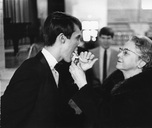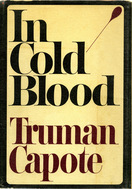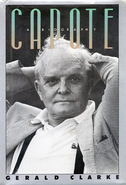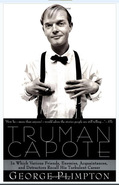Revisiting a Book
 The Author at Eleven
The Author at Eleven  The Author as Choir Member
The Author as Choir Member  The Clutter Home Outside Holcomb, Kansas
The Clutter Home Outside Holcomb, Kansas Capote’s “non-fiction novel” read, to an eighteen-year-old, like a sensational piece of literature—something right off the newsstands, yet with much more to offer, if only, as a callow youth I might have been able to discern its finer qualities. I’d seen nothing of Truman Capote’s writings prior to that. I had no idea who he was, what he had accomplished (in his early forties by then)—didn’t realize as many others wouldn’t, that the best part of his career was over. I read from ICB every chance I got. Other choristers talked and laughed, seeking, at times, to engage me, but each time we re-boarded our bus I continued to travel with Capote as he crisscrossed the state, the nation, as he traveled from New York to Kansas and back. Reading the account is like witnessing a train wreck in utter slow motion, from its very departure until the murderers are hanged. That paperback is one of the few books of that time period to get away from me. I can't imagine where it went to.


Revisiting the Cinema

Still, I’m drawn into Infamous, the calamity that is Capote’s life: the gossipy tongues that wag in New York giving Capote something to write about (most assuredly in his unfinished book Answered Prayers) until murder in Kansas calls to him; the two wardrobes of mid-century America, one for Manhattan and one for the heartland; the breathless relationship between Capote and Smith, in which the latter realizes he loves Capote and declares it and Capote reciprocates; Capote’s insistence on burying himself in the lives of these people; the rigors that the writing of this book requires in concert with his Olympian efforts to consume drink, so that he can produce the greatest book of his career. And yet we know he never writes anything of significance again. He drinks himself to a hauntingly premature death, almost in salute to his inability to write. By contrast, Harper Lee, two years younger, still lives at this writing. Capote knows what it would take to top himself and he has nothing left to give. When a writer cannot write, it is like experiencing death. Capote only wants to make it official, and yet, as his character claims, “Alcohol is the coward’s way out.” He cannot end his life swiftly. He must mock it, taunt it, tease it, draw it to a close as only some alcoholics can: with great drama and a habit that cannot be broken, for if it is, he will have to face the truths of his life.
In the other film, Capote, based on Gerald Clarke’s book, the narrative is more staid. Thankfully, no re-creation of the murders exists except by way of Perry’s confession. This version would have it that Perry does not reveal to Truman what happens in the Clutter home until the very end of their relationship, when Capote is trying to end the book. Much is made of Capote’s ability to find the boys a better lawyer—which I come to see as a stalling tactic that allows him more time to write. Again, I both love and hate this character played by Oscar-winning Phillip Seymour Hoffman. Someone sends Perry a newspaper account of Capote’s New York reading, in which the author recites segments of the first three parts of the book and reveals the title In Cold Blood, one supposes, to build interest, so that when the book finally appears, it will inspire sales. Today, we would call such a process “building a platform.” Later, when a knowing Perry asks Truman what the title of his book will be, Capote lies through his teeth: “I really have no idea, Perry.” He constantly placates Perry and assures him of his sincerity, yet one isn’t sure it’s real, not even, I think, Capote himself.
Before Capote witnesses Perry’s hanging, he is allowed to visit both killers one more time under crowded supervision—at least four other prison officials are present—and the tenor of the conversation is jovial on the part of the killers trying to keep a façade of bravado up to the last. Capote is flummoxed by them, the situation, unable to get beyond superficial speech. He exits, saying several times that he is sorry, that if he could save them he would—almost as if his leaving the room will cause their demise. He’s already tried more than any other human being to “save” them— although life imprisonment would hardly seem like salvation. Had they been allowed to live out their lives in prison, they might still be alive.
In most ways, Capote is the quieter film, though I don’t remember it that way before my recent viewings. There exist minor but strange discrepancies between the two versions, based, according to film credits, on the two previously mentioned biographies. In Capote, Harper Lee chauffeurs Truman around Finney County, Kansas in a 1955 Chevrolet, a rather old rental for the early 1960s. In Infamous, she drives a 1959 model. This scenario is more likely if the car is indeed a rental and not a loaner. And which one of the locals would lend them a car? In Infamous, Bennett Cerf accompanies Capote to the hanging in Kansas; in Capote, it is Mr. Shawn, Capote’s editor. I don’t believe both can be correct unless both men are present. There exist pictures of the actual Clutter house on the internet. Neither dwelling in either film comes close to matching the original in architecture or its forlorn, isolated character on the plains of western Kansas, somewhat more treeless (except for the shelter belts) than the Canadian landscape where Capote is filmed.
I thought I would be able to say definitively, after viewing both again, which is the better film, but I find that an impossible task. Each is a work of art, brought to life by different directors, conceived and underwritten by the support of different producers. In the Infamous portrayal of Harper Lee, Sandra Bullock is quieter, her range as a character not fully explored—though it is a fine attempt by a major talent to reach beyond her commercial fare. As the other Harper Lee in Capote, Catherine Keener seems more fully realized, a true friend to Capote, and, in the role, more capable of telling Truman the harshest truths about himself. She is, for example, able to walk away from him when he insults her on the eve of To Kill A Mockingbird’s film release in New York. “I don’t see what all the fuss is about,” Capote says, slurring his words and sipping what one can assume is his umpteenth Martini. Hoffman’s Capote knows what the fuss is about; he must be wondering if his book will stand up to the success of Lee’s. Will he, too, receive a movie deal? And so Harper Lee, instead of taking the bait, sails back into the happy maelstrom of her post-premier party, to enjoy it to the hilt because even she may realize it will be her first and only film premier.
Because Hoffman has created so many fine roles including a macho homophobe in The Talented Mr. Ripley, his performance as Truman Capote is perhaps the most difficult to accept, whereas Toby Jones is so unfamiliar to American audiences that his portrayal seems, at times, to outquirk Hoffman’s. And yet Hoffman’s interpretation may have the greatest depth, if only by degree. There exists in his performance a playful arrogance missing in Jones’s youthful wistfulness, a sense of humanity that seems to grow as the film progresses—whether the scenes are shot in this order or not. In good fiction, in good film, both, I expect a character to grow in some manner, and it is Hoffman’s Truman that appears to grow the most.
Either way, I am left with my original curiosity about the murders. How can anyone kill four innocent people? Further, why can’t Richard Hickock and Perry Smith enter the house in masks, and, finding that there is no large sum of money to be had, leave the Clutters bound and gagged for the night—alive—so that when Nancy Clutter’s friend discovers them the next morning, the two men might only be sixty dollars richer and perhaps hundreds of miles away, free to rob once again and face a different flirtation with death? The tale of robbery would otherwise remain a family narrative, a short story the Clutter people tell their children on dark, cold nights when the wind blows across the plains like a knife shearing anything in its way.

 RSS Feed
RSS Feed